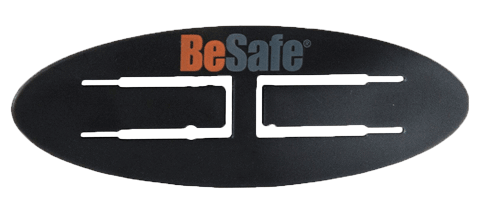A common question I get asked is how to stop a child from wriggling out the harness.
This places them in an extremely dangerous position if they were to be involved in a crash. Not to mention how distracting and distressing it is to the driver!
So why is Escaping a car seat such a big deal?
If your child's car seat straps are too loose, or off your child’s shoulders, they could slip their arms out the harness. This could cause them great danger in a crash. They could be thrown forward and hit into the front seat, called submarining, or they could be ejected from their car seat.
This shocking video demonstrates what happens in a crash when the harness is not over the shoulders as they should be:
Video credit from 5 Point Plus
tips and tricks to stop your Toddler escaping their Car Seat
1. Check the harness height at the shoulders
Your car seat manual will show you how to adjust the harness height. It is useful to check the harness height every time your child outgrows their clothes or shoes. Chances are that the car seat needs adjusting then too!
For rear facing car seats , the harness straps should come from at or just below shoulder level (within an inch). Putting the harnesses too high for a rear-facing car seat causes the child’s body to slide upwards against the car seat in a crash. Straps that are too low allows the straps to slide off the shoulders easily.

.
For forward-facing car seats , the harness straps should come from at or above shoulder level (within an inch). Crash forces will cause a forward facing child’s body to be thrown forward. Straps that are too high or too low allows extra wriggle room to escape.

Correctly positioned straps most effectively decrease the amount of distance the child will travel when propelled forward and reduce the forces on the child’s spine and shoulders.
2. Tighten the harness every time you put your child in the car seat
It is very important to pull the slack out of the harness from the hip area before pulling the tail to tighten it at the shoulders. Too much slack at the hips can allow children enough room to get their arms out.
The straps should be tight enough so that you cannot pinch the webbing. We call this the "pinch test".

Watch our short video for a demonstration:
3. Anti-escape device
If the tips above are still not deterring your little escape artist, you may need to invest in an anti-escape device.
There are ONLY 3 such devices that have been crash tested and are recommended by car seat technicians; the Besafe Belt Collector, the Besafe Belt Guard and the Cybex Sensorsafe.
None are universally approved. Aftermarket products that are not approved by your manufactured are not recommended. However, if your child continues to escape the harness despite it being at the correct height and tightened properly, the Belt Collector, Belt Guard or Sensorsafe may be a safer alternative to an unrestrained child.
It is not safe or recommended to use any other gadgets or devices. Other items used to keep your child harnessed, although widely available, are not crash tested and could cause more harm than good in a crash.
1. BESAFE BELT COLLECTOR
The Besafe belt collector is a plastic clip that slides onto the harness, it is legal and crash tested. It is officially only approved for use on BeSafe car seats, but does fit other car seats. .
It is NOT the same as a chest clip, which is illegal and dangerous on European car seats. It is officially only approved for use on BeSafe car seats.
2. BeSafe belt GUARD
The Besafe Belt Guard holds the shoulder belts safely together, preventing children from wriggling their way out of their harness.
The BeSafe Belt Guard is crash-tested at a renowned test institute and complies with the strict requirements of UN R129. By being installed permanently onto the shoulder pads, the Belt Guard makes buckling the child up easy and uncomplicated and can be used with all BeSafe toddler seats.
The patented design of this solution allows for closing and opening the Belt Guard in just one action, thereby enabling taking the child out of the seat quickly in any situation.
Through this, the BeSafe Belt Guard offers parents a functional and proven solution for making sure that their little escape artist stays safely in the child car seat’s harness at any time.
*The Belt Guard is ONLY compatible with Besafe toddler car seats and does not fit other brands.

Technical information:
- Approved within UN R129
- Does not have to be adjusted in height as the child grows
- Easy to open and close when the belts are loose
- Compatible with BeSafe toddler seats only
- Crash-tested
3. CYBEX SENSORSAFE
Cybex Sensorsafe fuses smart technology and smart design with the introduction of SensorSafe: a unique child monitoring system that ensures the safety and health of your child. The SensorSafe clip attaches to the harness system, keeping you informed of the safety and health of your seated child at all times.
SensorSafe provides essential alerts to help prevent critical situations:
1. When your child unbuckles the clip,
2. When the ambient temperature of your child is too hot or too cold,
3. If your little one is left unattended in the car,
4. And if your child has been seated for too long.
All alerts are received via Bluetooth on your smartphone through a user friendly app that also provides guidance on installation, how-to videos, FAQs and more. Compatible with all Cybex infant and toddler car seats. Vehicle must have an OBD (On Board Diagnostics) port in order to work.
Conclusion
Using the above tricks and/or accessories should keep your child safe in their car seat. If you are still having difficulty keeping your child restrained in their car seat, please post on Car Seat Support South Africa or contact julie@preciouscargo.co.za for further advice.




Shawn
These are SO RIDICULOUSLY PRICED! Parents and grandparents with escape Artist kids, ind cars seats/ cannot afford rent, groceries!
This is a growing problem with parents that don’t make kids mind. Products should be made for every station in life.
I know of a mom who’s kids (2&4) constantly get out of their CS and dart immediately into parking lot.